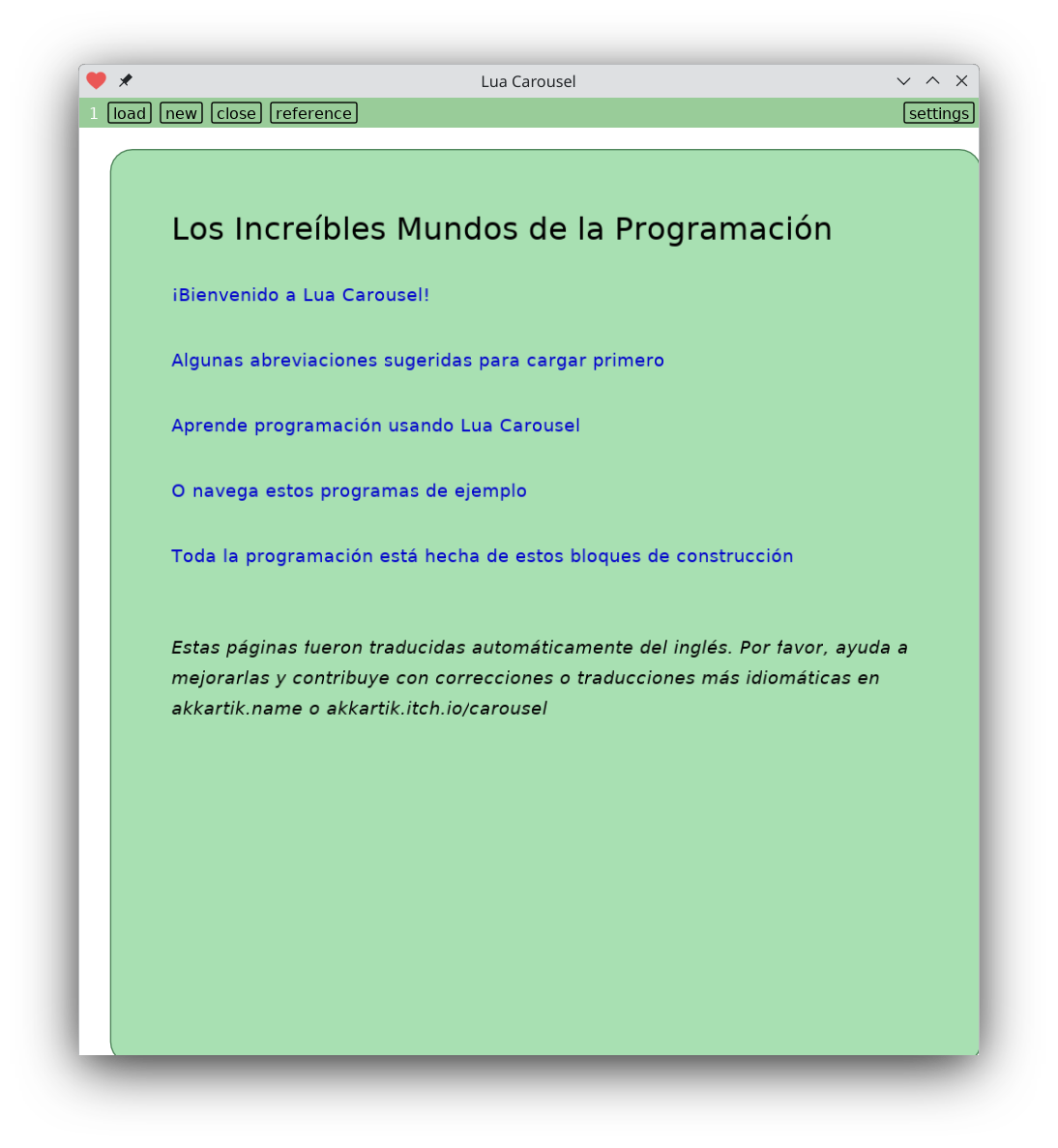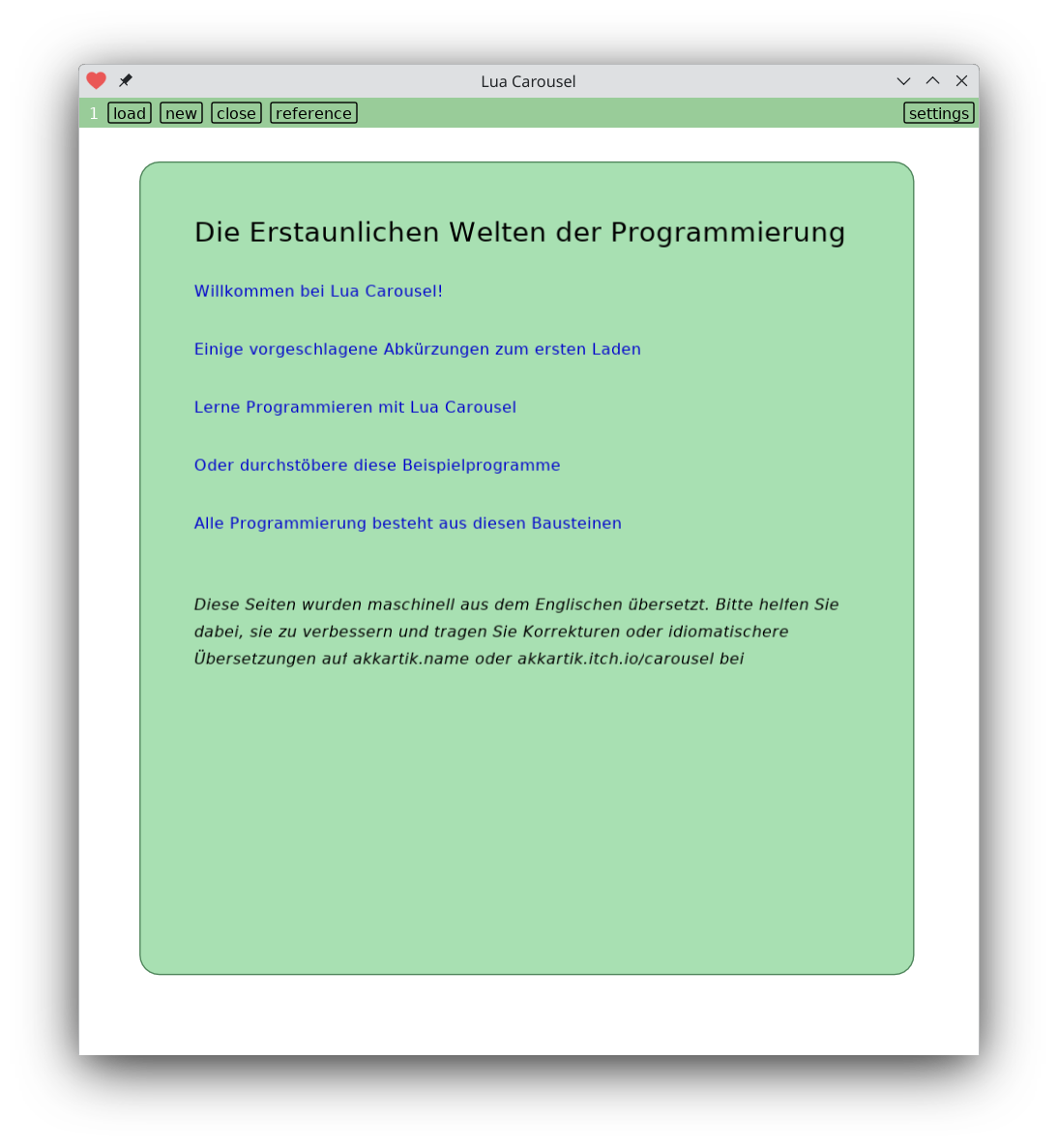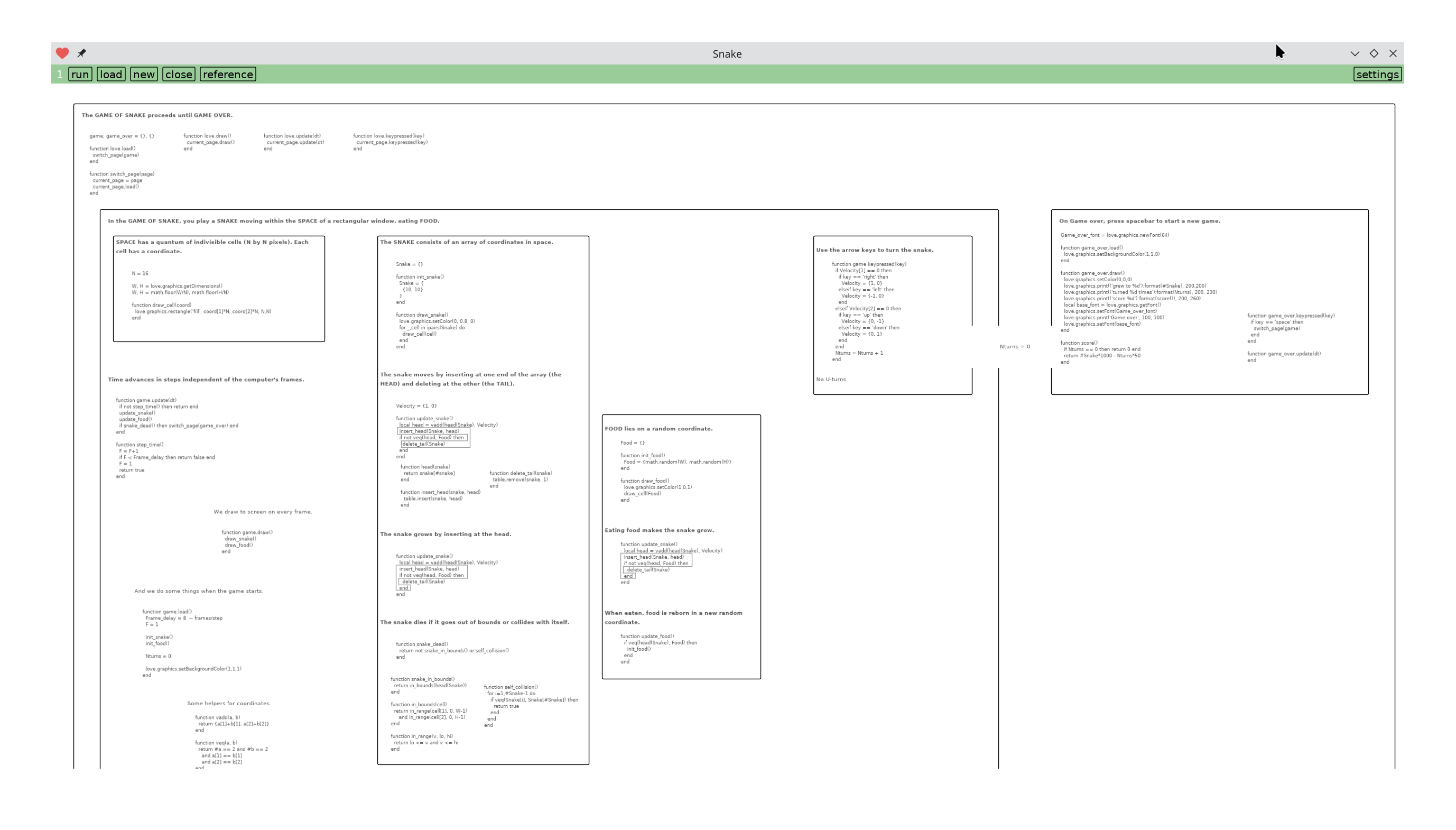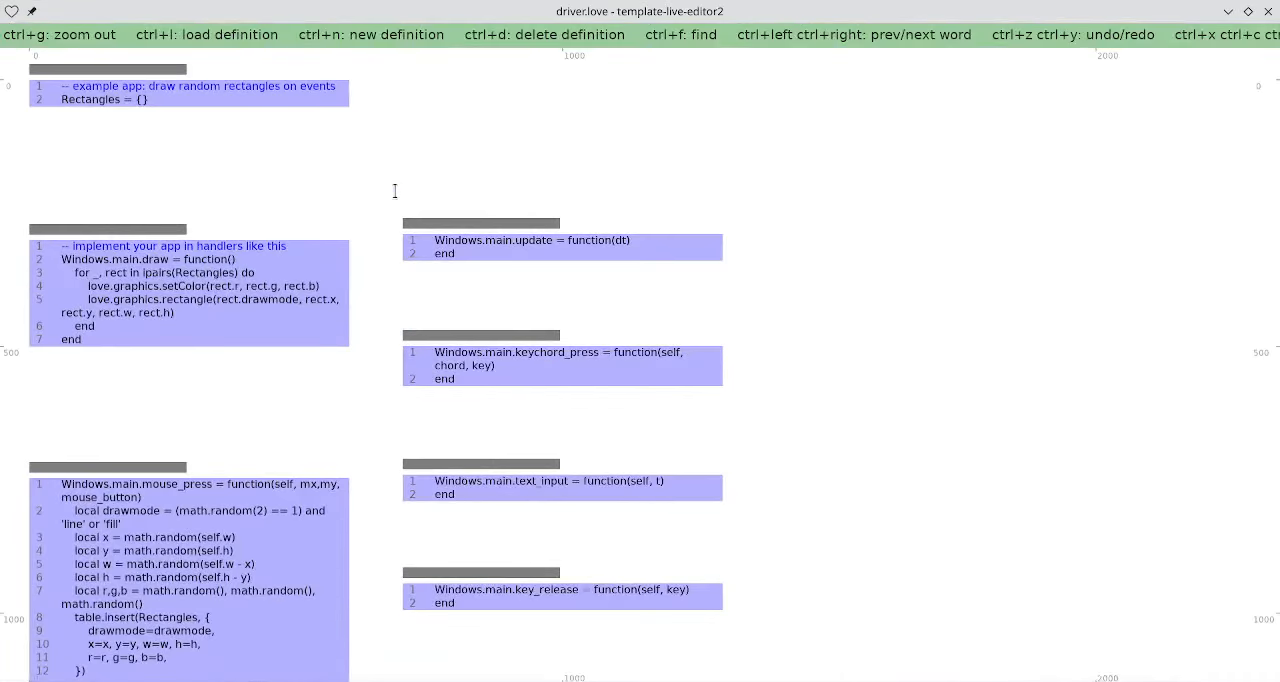Easy to download. Easy to run. Easy to modify. Easy to share.
- Free and open source. I'm not trying to make money from them, only meaning. I'm beholden to nobody. No dark patterns, ever. I'll never sell them to someone else; there's nothing to sell.
- Built atop a small platform that is more secure and trustworthy than mainstream web browsers. The download is 5MB. No install process on most OSs.
- All apps reward curiosity. I care about the experience of making changes to them as much as the experience of using them. You can often look inside the app you're running and modify it with the press of a button, without needing additional software.
- Each app quickly stabilizes, and then seldom updates. Because timeless software is safer and more trustworthy (it can't change its mind). Definitely no auto-updates. I think I might be able to get to 50 years without an update. Join me on that voyage!
- Individual apps stay simple; apps spawn forks and remixes rather than grow complex.
More details in this talk & transcript.
To start using your computer more freely and safely, try out one of these apps (the others can wait):
- A plain-text editor you can draw line-drawings in. And export to SVG or html. (code)
- A small environment for writing small, throwaway programs on phone or computer. (code) Create your own scripts or copy and run one of 30 (and growing) useful/fun scripts (fractals, cellular automata, voice recorders, equation plotters, games) from the devlog. If you wish for or have an idea for an app or script — don't hesitate to ask!
- A small tool for drawing box-and-line diagrams. (code)
All the apps
A family tree, with forks indented below their parents. If multiple forks need a change, it's often convenient for me to make the change as high up (unindented) in this tree as possible.
lines.love: The original plain-text editor you can draw line-drawings in.
- lines-polygon-experiment: A new way to draw polygons.
- lines-and-links: A few lines modified to support clickable links. If a word surrounded by whitespace corresponds to a filename it gets an underline and becomes clickable. Now pulled into some of my other apps.
- lines-cjk.love: A place to support CJK languages. Currently only has a font change, because I don't know any of these languages. If you'd like to help, please get in touch.
- lines-mobile.love: lines.love tested for mobile devices. Adds a file picker where the original switches to new files when you drop their icons on the window.
- etch.love: an ephemeral slate you can write and draw shapes on, then export to html+SVG with the press of a button.
- pensieve.love: The app I use for all my note-taking. Manages 800MB of notes over 20 years.
- techmeet.love: fork of pensieve.love for a specific community. If you'd like one for your community, please get in touch.
- capture.love: A secondary tool for pensieve.love. Sometimes I just want to capture a note on a blank slate without getting distracted by the giant dashboard of all my notes. But what I capture here still becomes available in pensieve.love.
- techmeet-capture.love: Secondary tool for techmeet.love.
- lines2.love: A new version of lines.love with radically rearchitected internals. Among other things, it enables structured editors to be more easily created. But it's also smaller, faster and more robust.
- text2.love: lines2.love with all the line-drawing support ripped out. Frees up complexity I can use to take it in new directions.
- view2.love: text2.love with all the editing support ripped out.
- fractions.love: A structured editor for fractions rendered vertically (with a horizontal divider rather than a slash as we've gotten accustomed on computers). Demonstrates the sorts of things lines2.love makes much easier to accomplish.
- notebook.love: A rudimentary computational notebook where you can write prose containing named blanks, and perform arithmetic in indented lines that fills in named blanks.
- highlight.love: A viewer for simple styled text with configurable colors.
- curio1.love: A little toy exploration of a tiny state space of 8 similar programs. See each one running, look at its source code, compare its source code with “nearby” programs.
- highlight.love: A viewer for simple styled text with configurable colors.
- notebook.love: A rudimentary computational notebook where you can write prose containing named blanks, and perform arithmetic in indented lines that fills in named blanks.
- tabs.love: Prepend 3 dashes to any line in a text file to turn it into a bookmark ‘tab’ in the right margin that you can click on to jump to it. This app embodies the kind of interaction I live for: somebody came up with the idea for it online, and I was inspired to build it for them. If you ever think of an idea and wish you could build it, please get in touch.
- doodle2.love: An experiment in drawing doodles alongside text. Doodles are attached to a specific character and move/delete with it.
- attributes.love: An experiment in maintaining ranged attributes as in Emacs.
- template-live-editor2: Template repository for a new approach to code editing. Forks of this app can be edited live as they run using the driver.love app below.
- carousel2.love: Lua Carousel, a small environment for writing small, throwaway programs on phone or computer.
- text2.love: lines2.love with all the line-drawing support ripped out. Frees up complexity I can use to take it in new directions.
- text.love: lines.love with all the line-drawing support ripped out. Frees up complexity I can use to take it in new directions.
- view.love: text.love with all the editing support ripped out.
- links.love: A few lines modified to support clickable links. If a word surrounded by whitespace corresponds to a filename it gets an underline and becomes clickable. Compare lines-and-links above; this one just doesn't have drawings.
- pong.love: An experiment in code editing. A game of Pong whose source code you can edit any time by pressing ctrl+e. Now this support has been pulled into many of my apps.
- template-live-editor: Older template repository for building live-editable apps. Fork any new apps from template-live-editor2 above. But all the forks below continue to work and can be live-edited. The protocol with driver.love has not changed.
- sum-grid.love: Little app for helping first-graders practice addition by solving magic square problems. I made this when my kids ran out of such problems in their textbook and were hungry for more.
- carousel.love: Lua Carousel, a small environment for writing small, throwaway programs on phone or computer.
- carousel-cards.love: An easy series of puzzles to trick yourself into learning programming. At every point you have a fully programmable environment available if the muse strikes and you want to forget the puzzles and build something new.
- template-carousel-mobile: Template repository for apps that can run and be modified on mobile devices as well as computers.
- sokoban.love: A client for Sokoban. Play 500+ puzzles on phone, tablet or computer. If you want to skip to a level far away, edit the source code. I believe it is possible to create apps with good UX that require editing their source code for some tasks. Tell me how far I am from demonstrating that.
- bf.love: Rudimentary interpreter for BrainF**k.
- broadsheet.love: A text viewer that wraps lines at a readable length, switching to multiple columns as it finds space.
- spell-cards.love: Rudimentary flashcard app for helping set spelling exercises for schoolchildren based on voice recordings of words.
- crosstable.love: Little tool for managing tournament cross-tables. Automates the drudgery of sorting rows and columns at once.
- luaML.love: A template repository for rendering a very simple markup “language”. There's no new syntax, you just work with Lua table literals.
- snap.love: A tool for drawing boxes and arrows. Probably my single most used app.
- ~alex27/snap.love: A fork for someone else with some custom features. If you'd like a custom fork of any app for yourself, please get in touch. My apps provide source code and are easy to modify, but it doesn't have to be you modifying them. You just have the option to make changes to them any time in the future. If you have ideas, I'd love to bring them to life.
- wardley.love: Tiny reskin of snap.love for drawing Wardley Maps.
- mastodon-unfurl.love: Visualize a Mastodon thread as a branching tree.
- driver.love: The editing environment I use for live-editing apps. Itself created by live-editing using itself.
- pothi.love: Mini browser for commenting on a directory tree of markdown files. I use
gitto exchange comments with others.
- pothi.love: Mini browser for commenting on a directory tree of markdown files. I use
- snap.love: A tool for drawing boxes and arrows. Probably my single most used app.
I also explore building with simple html that you can save from your browser and run locally without needing to run a server.
note.html: A place to jot down notes and images by Cristóbal Sciutto Rodríguez.
- table.html: A table you can edit on your browser. Though you still need to adjust rows/columns outside the browser.
- tz.html: A timezone converter with minimal interactivity, that you can share around confident that everyone is seeing exactly the same thing you are.
- annotations: An environment where you can paste in some text, then annotate it on a second column and save your annotations locally alongside the text.
I'll also include here an “approll” of simple offline-friendly html apps by others that I admire and have been influenced by:
· note by Cristóbal Sciutto Rodríguez, the seed for all my html projects so far.
· Yon, m15o's text editing environment inspired by the Plan9 Acme editor.
· ink n switch, Eli Mellen's text editor that you can also doodle on.
· Tom Larkworthy has been doing some fascinating work to make Observable offline-friendly.
Coming soon: networking. Freewheeling Apps will become much more useful when you can use them to get your data out of other silos service providers.




